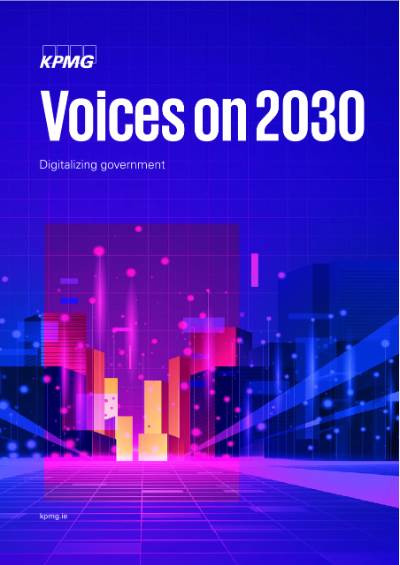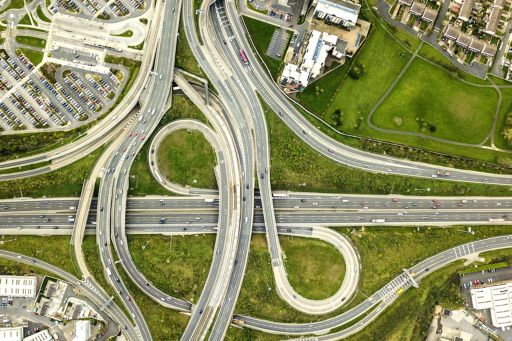What will citizens expect from government in 2030? What will the leading governments look like? What will be the impact on service delivery, assets and systems? How will policy and regulation need to change in response? These are the types of questions governments need to answer if they want to transform for the future. But it is difficult to plan a journey if you can’t picture the destination.
This report offers a view of 2030, from 2030. KPMG professionals spoke with dozens of leaders and visionaries from around the world to envision what the world might look like in 2030, how we got there and what the big challenges were along the way. Their predictions for the industry span the five areas in which KPMG professionals also envisage dramatic change.
Explore the five areas of disruption in 2030
Cognitive technologies enable natural and intuitive human interactions |
|
Government services are seamless and intuitive. |
|
Web 3.0 has unlocked the metaverse. |
Imagine that one morning on your way to work you pass a small hole in the bike path. “There’s a pothole here,” you mutter into your phone mic. The next day the pothole is gone. How? Cognitive and intuitive government. You told your phone that you saw a problem. It used voice-to-text technology and analytics to surmise that this was an infrastructure issue. It captured your exact location and submitted the information. That translated into a work order, a road crew (one human and one automated machine) and a resolution. Simple. Intuitive. Cognitive. This is the world of 2030.
Perhaps one of the most noticeable changes in the customer relationship in 2030 is that much of it now happens in virtual reality. Web 3.0 and the metaverse have created spaces where many citizens now interact with government and healthcare professionals, as well as private companies and communities. More and more often, virtual worlds are becoming the channel of choice for both citizen-customers and governments.
Web 3.0 and the metaverse have forced governments to rethink their role in a decentralised world. |
|
Government operating models have become more agile, cooperative and resilient. |
|
The shift to Web 3.0 is pushing transformation into new domains. |
Governments in 2030 have recognised that their role in a decentralised world is remarkably different from the past. Government operating models have become much more agile and open. In fact, many governments now actively ‘crowdsource’ code development from citizen developers, creating a resilient and agile network of capabilities that drives diversity and enhances trust. In doing so, governments have created a more flexible, resilient and responsive platform upon which they can deliver services.
At the same time as having to rethink their role in a decentralised world, government has also had to rethink their presence. In 2030, trillions of dollars are spent in the metaverse and it is used by billions of users. And those numbers are growing exponentially. Citizens have discovered that Web 3.0 is more secure, flexible and agile – they are leaving Web 2.0 platforms in droves. Governments needed to quickly develop their capabilities in the metaverse in order to properly receive data and act on it accordingly.
Consumers have moved quickly to adopt the decentralised and self-sovereign data aspects of Web 3.0. |
|
Trust and data security have been completely redefined as new technologies like quantum computing become more accessible. |
|
Governments have been forced to adapt in response. |
Not so long ago, NFTs were considered a novelty. By the mid-2020s, however, people had realised they could use NFTs to hold and manage their own personal data. Smart contracts could be created to unlock certain bits of data, to certain users, for very specific uses. Data started to become decentralised and self-sovereign.
In part, this was driven by the introduction of Web 3.0 which, itself, is based on a very decentralised data and management architecture. Web 3.0 architectures gave people the tools they needed to take ownership of their data. Security breaches into the big cloud data lakes raised concerns about how personal data was being managed. And that catalysed a movement of citizens and businesses eager to take their data back from the centralised and opaque data lakes they had resided in before.
The evolution from Web 2.0 to Web 3.0 was not only driven by companies or governments – it was also driven by citizen demand for a different way to organise data.
Low-code/no-code solutions and automation tools are commonplace for governments. |
|
Citizen developers are transforming their lives and organisations. |
|
An infusion of digital natives and new capabilities are changing the nature of work. |
In 2030, when an individual is tasked with something mundane, they are likely to just automate it. And it’s easy. With low-code/no-code platforms, almost every citizen has the tools and capabilities they need to create or customise an app. Drag-and-drop user interfaces and pre-built components have almost eliminated line-by-line coding. Citizen developers are everywhere.
The adoption of low-code/no-code has allowed a much broader, non-technical audience to start rapidly building solutions. That, in turn, has helped reduce the skills gap that had been slowing the pace of digital transformation. It has given workers the power to customise solutions to meet their actual needs and realities, thereby driving enhanced productivity and efficiency. It has allowed organisations, public and private, to become much more agile and customer-centric.
In the public sector, low-code/no-code has allowed employees to design, test and fully deliver bespoke apps in days. Many government employees use their skills to customise massive enterprise solutions to suit their unique needs or circumstances.
Progress on environmental, social and governance (ESG) agendas are accurately measured through Web 3.0 and the Internet of Things (IoT) devices. |
|
Digital twins and virtual worlds allow people to understand the impact of decisions. |
|
Government investment into new technologies and models has sparked sustainable growth. |
Web 3.0 architecture has allowed sensors and IoT devices to be linked together in unprecedented ways, providing citizens and decision makers with detailed data on their actions and activities in 2030. Also, city planners and asset developers use digital twins and virtual worlds to simulate everything from the development of new transit systems through to the design of tiny individual components. As a result, government investments are much more efficient, effective and environmentally sustainable.
There have been heavy investments into space infrastructure to help measure and manage environmental change on earth. And there’s a combination of different sources of data to help us understand human impacts and risks in a much deeper way.
Government investment has also helped spawn several growth industries and service areas that are helping contribute to more sustainable economic growth. Governments have helped foster massive AI ecosystems and have invested into public sector solutions for the metaverse. In each case, new industries and innovation have emerged that serve the wider population, create new jobs, attract talent from overseas and drive further investment.
Start today. Be ready for tomorrow.
Based on these predictions, what tangible steps can government and public sector organisations start taking today? Here are six ideas.
- Start fresh with a bold, holistic vision. The world of 2030 is not necessarily an incremental change from today. It is a new paradigm that can require fresh thinking and bold, holistic action. Instead of starting with the status quo, try starting with the needs of citizens. And go from there.
- Learn about Web 3.0 technologies and trends. Web 3.0 is very different to the internet of the past. It is founded on different technologies and controlled in different ways. It may change the way you think about your business or area of focus. It’s worth learning about it now.
- Prepare your future talent and workforce models. Think about how you are going to encourage digital natives to join and stay with your organsation. And consider how you will develop your current employees to thrive and innovate in a Web 3.0 customer-centric world.
- Reassess your governance models. New governance practices are being introduced that may require significant changes in the way regulation is created and enforced. At the same time, the decentralisation of data will require new concepts around data protection and consumer security.
- Picture yourself in the metaverse. There is little doubt that the metaverse is becoming a key channel and technology for connecting people with governments and service providers. Act now on pilot projects to explore what your presence in a metaverse might look like and how you could serve your customers there.
- Form your ecosystem. In a decentralised world, government is part of an ecosystem of players and enablers that work together to meet the needs of citizens. Now is the time to start forming those relationships and engaging in pilot projects to help build experience and define new models.
Get in touch
The pace of change is challenging leaders like never before. To find out more about how KPMG perspectives and fresh thinking can help you focus on what’s next for your business or organisation, please get in touch with our team below. We’d be delighted to hear from you.
Cormac Deady
Partner, Head of Government & Public Sector
KPMG in Ireland
Cillein Barry
Partner
KPMG in Ireland
Paul O'Neill
Managing Director, Infrastructure and Government
KPMG in Ireland


